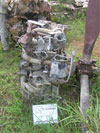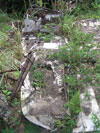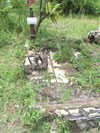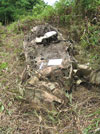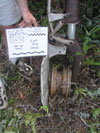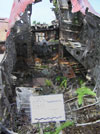 |
at the Old Colonia Airport, Yap State
Federated States of Micronesia
Site #1
Identification: Nakajima BN5 “Kate” dive bomber based on comparison with published specifications and examples. Parts of another unidentified single engine aircraft.
The engine from the Kate and the wing from the unidentified plane are said to have been removed by collectors from Japan in the 1980s, and then returned to their present locations.
The engine and a wing portion from the unidentified aircraft are in a near by gully that may be a bomb crater; they appear not to have been moved.
Kate: The engine next to the end of the Kate fuselage is generally corroded, but not too seriously for its age. A partial propeller and exhaust system are still attached.
The steel cylinders in this engine are corroded through. The blower and accessory case are missing, having been unbolted and removed. Some rocker covers have been removed while others are broken or otherwise damaged. The cylinder heads are broken. Skins on the fuselage are low on corrosion, but the paint has been faded by long exposure to sunlight and the elements. Shrapnel damage is evident over much of the surface. Corrosion is high in areas close to or contacting the ground. All removable components (controls, instruments, placards, etc) are missing. The spar caps are highly corroded, exhibiting complete exfoliation.
A tail section that matches specifications for Kate lies badly corroded flat on the ground, damaged by shrapnel. Unidentified Plane: The right wing of the unidentified aircraft is lying upside down on ground with its gear sticking straight up. This gear appears too long to be from a Zero. The wing is highly corroded and partially crushed. The left gear is lying on top of the right wing. The gear legs are in fairly good condition, but the wheels, which appear to be magnesium, are highly corroded. The left wing – badly damaged and corroded – is located in the gully at the north end of the site.
Engine #2, also in the gully, is missing its propeller blades; its hub is intact and includes a cowl with air intake ducting. A crushed fuel tank and a possible gear leg lie nearby. There is no evidence of vandalism or other recent human damage, though it is possible that parts of the aircraft were bulldozed into the gully during airport construction.
Click on each photo below to open a full-sized image in a new window.
Site #2
Identification: Mitsubishi A6M2 Zero fighter based on folding wingtips, no outboard wing tanks, balance tab, inboard aileron, folding wing tips; low air intake on cowl; ring exhaust manifold.
Engine: Highly corroded, possibly from a fire. Propellor blades are deeply pitted, two bent and one broken. One blade shows evidence of bullet holes. Corrosion is heavy on nose and crankcase and cylinders are rusted through. Most all accessories and components have remained on this engine with damage most likely the result of bombing, strafing, etc.
Wing: Both outer wing panels are broken and drooping toward the ground. The left wing seems to have been damaged from shrapnel and failed because of corrosion. The right wing has likely failed from corrosion. The main spar caps are highly corroded and exfoliated. All the single engine planes examined exhibited this extreme corrosion of the spar caps. The skins exhibit what appears to be damage from shrapnel and perhaps small arms fire. Both gear legs are intact and down. Interestingly, the chrome on the oleos is in relatively good condition. The legs are rusted, but not severely and the gear doors exhibit little corrosion. The wheels are almost corrosion free, the exact opposite of the situation observed at Site #1. Presumably the wheels are of different alloys. No evidence of tires. Leading edge and wingtip from right wing are missing, many rivets popped from corrosion.
Fuselage: The fuselage aft of the cockpit is missing. The forward fuselage is mostly missing, exhibiting possible damage from explosion and fire inside the cockpit area. Some skin punctuations in this area are from the inside out. Slag from melted aluminum is accumulated around the forward spar. Fire damage, aft cockpit; most everything in cockpit area is destroyed.
Graffiti: Names have been scratched into the primer on top skins and fuselage.
The whole area under the wing appears to have been burned; the fuel tanks are missing and their bays are destroyed. This is consistent with an explosion in the cockpit area that blew off the engine and front of plane, ignited both fuel tanks and burnt everything under the wings. Fire damage has accelerated the corrosion on this airframe. It is highly corroded underneath, despite being elevated enough that it is not in contact with the ground or vegetation.
Virtually everything small that can be removed from this wreck has been removed.
Site #2 with Site
#3 beyond. |
Site #2: Engine
showing corrosion. |
Site #2: Condition
of propellor. |
Site #2: Drooping wings. |
Site #2: Left wing at break. |
Site #2: Right wing at break. |
Site #2: Exfoliation of spar caps. |
Site #2: Shrapnel or bullet holes, left wing. |
|
Site #2: Right landing gear. |
Site #2: Example of popped
rivets. |
Site #2 showing absence of
tail section. Site #3 in background. |
Site #2 looking aft into cockpit
area. |
Site #2: Holes punctured from
inside out. |
Site #2: Slag in cockpit area. |
Site #2: Graffiti scratched
on fuselage. |
Site #2: Evidence of fire,
loss of fuel tanks. |
Site #2: Advanced corrosion
on belly. |
| Appendix p. 1 | Appendix p. 2 | Appendix p. 3 |
Appendix |
 |
Copyright 2021 by TIGHAR, a non-profit foundation. No portion of the TIGHAR Website may be reproduced by xerographic, photographic, digital or any other means for any purpose. No portion of the TIGHAR Website may be stored in a retrieval system, copied, transmitted or transferred in any form or by any means, whether electronic, mechanical, digital, photographic, magnetic or otherwise, for any purpose without the express, written permission of TIGHAR. All rights reserved. Contact us at: info@tighar.org • Phone: 610.467.1937 • JOIN NOW |





